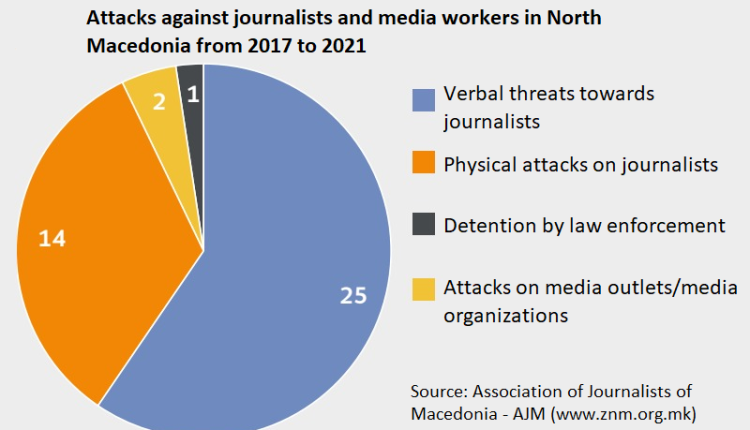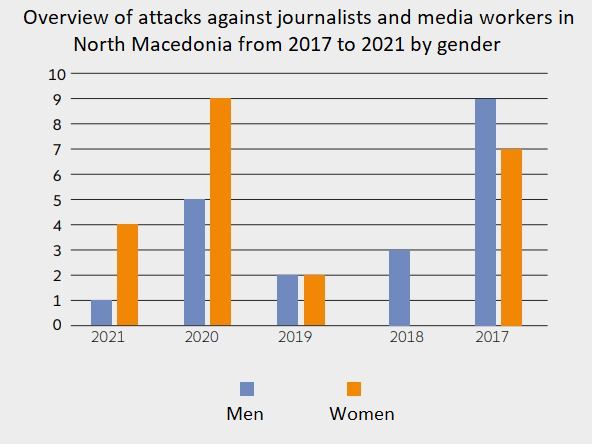Three verbal attacks on women journalists in 2021 come from political figures. It speaks a lot about the low culture of public communication in the relationship between a holder of public office and a journalist, but it also speaks about the fact that holders of public office are easily encouraged to make threats against women journalists in North Macedonia. It is important to underline that no official court case has been issued by the Public Prosecutor’s Office or the Ministry of Interior, despite the fact that some of the threats were reported to the police. This information is according to the latest publication “Attacks on Journalists and Media Workers 2017 – 2021: Tendencies and Recommendations” in which AJM covers some of the more serious violations of the rights of media workers in the country, writes Truthmeter.mk.
Under the syndicating agreement between Truthmeter.mk and Meta.mk, we republish the text below:
Author: Meri Jordanovska
In the period from 2017 to 2021, as many as 42 attacks on journalists and media workers were registered in the AJM Register. The most common form of threat to the safety of journalists is verbal threats.
Out of 42 cases of attacks on journalists, as many as 25 are cases of verbal threats against journalists, 14 are physical attacks on journalists, two are attacks on media organizations and one attack is in the form of imprisonment of a journalist.
This is shown by the latest publication titled “Attacks on Journalists and Media Workers 2017 – 2021: Tendencies and Recommendations” in which the Association of Journalists of Macedonia (AJM) covers some of the more serious violations of the rights of media workers in the country.

The first conclusion that can be drawn from the publication is that the number of attacks on female journalists is higher than the attacks on male journalists in the last two years.
Sexist rhetoric is often used, giving these attacks an extra feature by the fact that they not only refer to the work of journalists, but also seem to be gender-based, according to the Association of Journalists.
The second conclusion in the context of the safety of journalists is that the frequency of attacks and threats against media workers increases in turbulent political situations, especially during elections. According to AJM, frequent labeling of journalists by politicians and public officials could further encourage party sympathizers to follow suit and continue to threaten the safety of journalists and media workers in a similar manner.
The third conclusion drawn from the analysis is that physical attacks on journalists have decreased during the pandemic, while online threats against journalists have increased significantly.
The fourth and according to AJM, the most important trend is the impunity of attacks on journalists.
Despite numerous domestic and international reports pointing to this issue, as well as numerous conferences dealing with it, the impunity of attacks on journalists continues and requires more serious commitment from law enforcement and judicial authorities, according to the AJM.
What kind of attacks have media workers faced?
In 2017, 16 attacks on journalists and media workers were registered in the AJM Register. Out of these, six were verbal attacks on journalists, nine were physical assaults, and there was one case of destruction of personal property.
In 2017, the “Bloody Thursday” occurred, i.e. the intrusion in the Assembly, when twenty media workers were attacked, and some of them sought justice in court. The Basic Civil Court in Skopje rejected their lawsuits.
Meanwhile, the only ones who have received justice for the events of April 27 are politicians. Their attackers are already convicted persons. This speaks volumes about the double standards in dealing with cases of violence against journalists versus politicians, as well as the enormous degree of impunity of the attacks on journalists, the publication reads.
In 2018, AJM registered three cases of attacks on journalists. Journalist Armand Braho was attacked during a conference of the Alliance for Albanians (AA) party in Struga. According to him, people from the Alliance for Albanians party harassed him, prevented him from broadcasting the conference live, and after the event, the journalist was physically attacked. The second case of an attack on journalists was registered in March 2018, when the brother of a senior DUI official made a death threat to the then president of AJM, Naser Selmani. The case was reported to the police, and after the strong public reactions, the Basic Public Prosecutor’s Office opened an investigation into the same case. However, despite the condemnation of the threats by the international community, despite the protest that took place in front of the Government of the RNM, the prosecution has not filed charges. In the third case, the police were involved. Infomax journalist Borislav Stoilkovikj was detained for allegedly refusing to identify himself during the filming and reporting of a protest, although a review of the footage revealed that Stoilkovikj wore a journalistic ID around his neck.
In 2019, four more serious cases of attacks on journalists were registered, as well as twenty other minor threats and incidents. The most serious attack was on the team of TV 21 in the Municipality of Aračinovo.
This attack contained elements of unlawful deprivation of liberty, for which audio and video recordings were published by the media. The case was not officially reported to the Ministry of Interior, due to which the Ministry of Interior claimed that it was not able to initiate a procedure. AJM has repeatedly stated publicly that due to the nature of the crime, it is necessary for the prosecution itself to take action ex officio. In the end, the case was not resolved, despite the fact that the mayor of Aračinovo, Milikije Halimi, publicly apologized for the incident, which confirmed that it really happened, explained the AJM.
AJM in 2020 recorded 12 threats against journalists, one physical attack and one attack on the media. Out of the 14 registered attacks on journalists in North Macedonia, in nine cases the victims of the attack were women journalists.
Women journalists are a more frequent target of attacks
Since the beginning of 2021, AJM has registered a total of five attacks, four verbal and one physical. What is worrying is that in 2021 most of these attacks (three) were aimed at women journalists.

This, according to AJM, is a continuation of the negative phenomenon observed in 2020 – the number of attacks on journalists to be greater than the number of attacks on journalists.
It is interesting that in all three verbal attacks on women journalists in 2021, the threats come from political figures. It speaks a lot about the low culture of public communication in the relationship between a holder of public office and a journalist, but it also speaks about the fact that holders of public office are easily encouraged to make threats against women journalists in North Macedonia. It is important to underline that no official case has been issued by the Public Prosecutor’s Office or the Ministry of Interior, despite the fact that some of the threats were reported to the police, says the AJM.
This worrying trend, according to AJM, could lead to a so-called “cooling effect” where women journalists self-censor themselves from further speaking, researching a particular topic or, in the most extreme cases, leading to a complete withdrawal from the journalistic profession.
Such inhibition is additionally driven by the inaction of the institutions or by the inefficiency in conducting investigations and gathering evidence. The Ministry of Interior as a tool in the hands of the prosecution is the only institution with access to mechanisms for gathering evidence in the online sphere where it is necessary to locate the attackers by IP addresses and the like. However, it must be noted that the final decision on whether to initiate criminal proceedings against the attackers is up to the public prosecutor’s office. The attacks on women journalists through various online platforms must raise the alarm in the institutions because living in the digital age has made the attackers braver, more confident and fiercer in their attacks, say the AJM.
Very often the attacks on journalists are from anonymous profiles on social networks or so-called “bots” that use VPN – a virtual private network, i.e. they can easily hide their trace in the online sphere and can hardly be located even by the competent institutions. The practice, according to AJM, has shown that the procedure for locating attackers using Internet platforms is difficult and slow, so it requires inter-institutional cooperation and requires domestic institutions – law enforcement agencies to be abroad using instruments of international legal assistance in gathering information in the pre-investigation procedure.
What next?
As a way out of these situations, AJM recommends several measures in order to protect journalists and media workers. Initially, the Parliament is required to pass the proposed amendments to the Criminal Code as soon as possible, for the changes of which the journalists’ associations and trade unions were consulted, where the qualified forms of the criminal acts that affect the journalists are applied. Furthermore, to increase the efficiency of the work of the Department of Cybercrime and Digital Forensics in order to easily find the perpetrators of online attacks on journalists and media workers. It also calls for the establishment of special units in the Public Prosecutor’s Office and in the courts that will be trained and specialized in the safety of journalists; improving the culture of public communication between political actors in order not to encourage offline and online attacks; monitoring and documenting hate speech and gender-based attacks on journalists in the Internet space by civil society sector etc.
Also, in the last report on the progress of N. Macedonia, the EC recommends that there should be zero tolerance for intimidation and attacks on journalists.
Attention should be paid to the labor rights of journalists. The recommendation is to impose a zero-tolerance approach to intimidation, threats and violence against journalists in the course of their profession and to ensure that perpetrators are punished, the EC report said.




















![Young people in a three-day-workshop learned about data visualization [Gallery]](https://meta.mk/wp-content/uploads/2023/12/obuka-za-vizuelizacija-na-podatoci-vo-dekemvri-2023--100x70.jpg)




